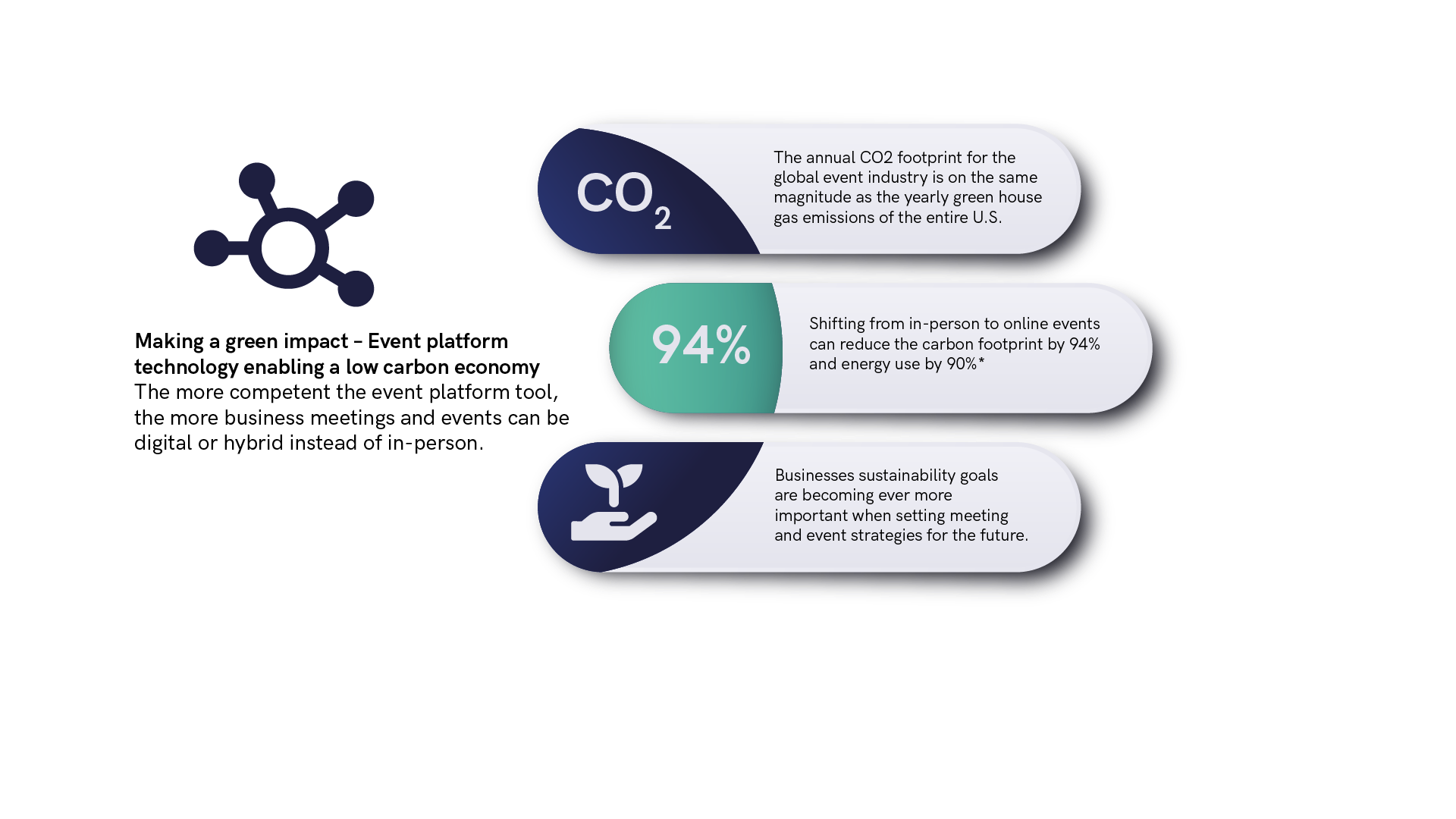

How can we balance environmental requirements with business objectives for meetings and events?
Environmental requirements for businesses are becoming increasingly stringent. Everyone must continuously pursue strategic work toward more sustainable processes without jeopardizing the effectiveness of the business or the dedication of the workforce. Important for employee engagement and customer relationships, physical events and meetings are also one of the largest sources of emissions.
Physical events and meetings are a contributing factor to global carbon emissions
The global event industry has expanded exponentially in recent decades. In 2017, more than 1.5 billion participants in over 180 countries participated in corporate events, contributing to $ 2.5 billion in spending and contributing to 26 million jobs. In addition, the number of regular international events doubles every ten years, and the market size for the event industry is expected to grow by 11% during this decade.

As the event industry grows, it also leads to significant emissions of greenhouse gases. According to an article from Nature, the carbon footprint per participant amounts to 3,000 kg of carbon dioxide equivalents according to previous studies of life cycle analyses. The carbon footprint of the global event industry is as large as the annual greenhouse gas emissions from across the United States, which means about 10% of global carbon dioxide emissions.
In 2020, the pandemic put an abrupt stop to physical events and meetings. Everyone quickly had to switch to virtual events and meetings, which significantly reduced emissions. The study from Nature showed that a transition from physical to virtual events can reduce energy consumption by 90% and the carbon footprint by as much as 94%.

The Paris Agreement and increased awareness among people have increased the pressure on companies to take sustainability measures. The results from the annual sustainability study Sustainable Brand Index show that Swedes’ interest in environmental and social issues is greater now than before the pandemic.
In other words, it is not sustainable or socially acceptable for companies to go back to arranging live events in the same way as they did before the pandemic.
Uncertainty about whether physical events will reach the same levels
Many event planners found it difficult when all physical events were abruptly canceled. With two years of almost exclusively virtual events, marketers are now eager to resume physical events. Although virtual events are good for many, physical events and meetings are about nurturing customer relationships. In this way, you can build relationships that lead to a higher conversion rate and maintain employee engagement. Three out of five marketers say that it is very important, even crucial, to resume physical events.
But the question is whether physical live events can return to the same level as before. The reasons for the uncertainties are many, not least the environmental aspects, but also the budget austerity measures that companies had to take during the pandemic. Companies in all sectors have needed to streamline their costs, and business travel is usually the first to be cut. Another reason is that during the pandemic, many employees have come to appreciate the flexibility of teleworking, precisely because they do not have to commute long distances to participate.

Reading tips: Fewer leads due to fewer event participants, what do we do?
To meet the high demands for environmental adaptation, budget austerity, and the needs of employees, marketers and event planners need to rethink and think new.
New ways of thinking and new forms of meeting
Recent years have brought several new and useful lessons for marketers. When the pandemic forced virtual events, marketers first wanted them to give the same results as traditional physical events. But many have now realized that virtual and physical events play different roles. Therefore, virtual events alone are not an up-to-date solution to meet companies’ needs for customer relationships and conversions, even if it is the most environmentally sustainable.
A good compromise between digital and physical meetings is hybrid events and meetings. Hybrid solutions that include both digital and physical components in carefully selected locations can reduce the carbon footprint and energy consumption by 66% compared to a fully physical event. However, hybrid events require more resources and skills because it includes more elements.

Another lesson was the benefits of collaboration between event planners. Previously, events tended to be spread across the organization’s business areas and geographic areas without any major justification, cost control, or value assessment. This often led to inefficiency and missed opportunities.
The future requires a more comprehensive strategy for events and meetings
To meet the new conditions, the event industry will need to adopt all the different forms of events and meetings. This means being able to arrange and carry out high-quality events, whether they are physical, virtual, or in a hybrid format. This must also be done in a way that is sustainable from an economic and environmental perspective.
It is required that you do not look at each meeting and event as an individual event, but take a holistic approach where all forms of events and meetings are part of well-oiled machinery. Where marketing departments collaborate and design a clear and comprehensive strategy that matches different events with the right goals. An overall strategy where environmental adaptation meets results in all events.

